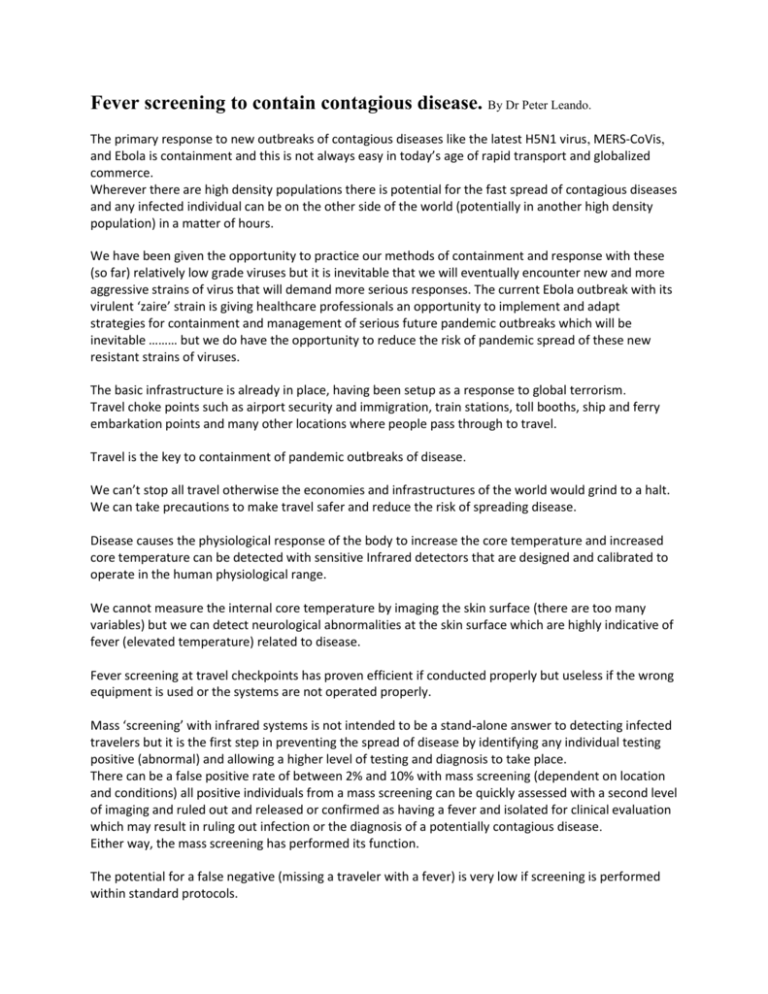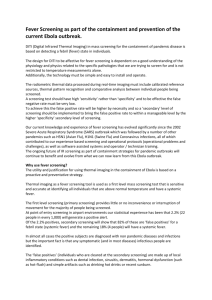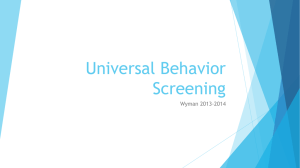Fever screening to contain contagious disease
advertisement

Fever screening to contain contagious disease. By Dr Peter Leando. The primary response to new outbreaks of contagious diseases like the latest H5N1 virus, MERS-CoVis, and Ebola is containment and this is not always easy in today’s age of rapid transport and globalized commerce. Wherever there are high density populations there is potential for the fast spread of contagious diseases and any infected individual can be on the other side of the world (potentially in another high density population) in a matter of hours. We have been given the opportunity to practice our methods of containment and response with these (so far) relatively low grade viruses but it is inevitable that we will eventually encounter new and more aggressive strains of virus that will demand more serious responses. The current Ebola outbreak with its virulent ‘zaire’ strain is giving healthcare professionals an opportunity to implement and adapt strategies for containment and management of serious future pandemic outbreaks which will be inevitable ……… but we do have the opportunity to reduce the risk of pandemic spread of these new resistant strains of viruses. The basic infrastructure is already in place, having been setup as a response to global terrorism. Travel choke points such as airport security and immigration, train stations, toll booths, ship and ferry embarkation points and many other locations where people pass through to travel. Travel is the key to containment of pandemic outbreaks of disease. We can’t stop all travel otherwise the economies and infrastructures of the world would grind to a halt. We can take precautions to make travel safer and reduce the risk of spreading disease. Disease causes the physiological response of the body to increase the core temperature and increased core temperature can be detected with sensitive Infrared detectors that are designed and calibrated to operate in the human physiological range. We cannot measure the internal core temperature by imaging the skin surface (there are too many variables) but we can detect neurological abnormalities at the skin surface which are highly indicative of fever (elevated temperature) related to disease. Fever screening at travel checkpoints has proven efficient if conducted properly but useless if the wrong equipment is used or the systems are not operated properly. Mass ‘screening’ with infrared systems is not intended to be a stand-alone answer to detecting infected travelers but it is the first step in preventing the spread of disease by identifying any individual testing positive (abnormal) and allowing a higher level of testing and diagnosis to take place. There can be a false positive rate of between 2% and 10% with mass screening (dependent on location and conditions) all positive individuals from a mass screening can be quickly assessed with a second level of imaging and ruled out and released or confirmed as having a fever and isolated for clinical evaluation which may result in ruling out infection or the diagnosis of a potentially contagious disease. Either way, the mass screening has performed its function. The potential for a false negative (missing a traveler with a fever) is very low if screening is performed within standard protocols. The alternative to mass screening with real-time (video) infrared imaging would be the slow individual testing of each traveler by a technician or nurse (one on one) and we have seen that this option causes major disruption to travel and would not be practical on a widespread or sustainable basis when high volumes of travelers are involved. The Meditherm Feverscreen 520 system was developed during the first SARS outbreak in 2002. The design approach was based on medical imaging criteria rather than industrial testing specifications. Meditherm, as a medical imaging device manufacturer has access to the expertise and experience of our medical professionals as well as our bio-medical engineers. The 520 system and the screening software has been continually updated throughout all of the outbreaks that have taken place since 2002 up until this latest outbreak. The major differences between the meditherm systems that are designed and built for fever screening and the industrial cameras that are adapted for fever screening is that the industrial cameras need an additional piece of equipment to perform affectively, a temperature reference source (black body) has to be placed within the field of view to calibrate each frame of the images. The operators of industrial cameras have to be specially trained to operate the camera and manually change the range and scale of temperatures and the false positive and false negative rates can be very high. The meditherm 520 benefits from a very sensitive narrow range of detection (limited to human physiology) and has an internal control reference for processing results. The agile auto calibration means that once the system is running it automatically performs the corrections for ambient temperature changes and the myriad of artifacts that can affect the accuracy of the results. The meditherm 520 does not operate with a manually set threshold temperature (that operators normally set too low because of false positive alarms). The Meditherm 520 threshold alarm will continually calibrate using proprietary algorithms and artificial intelligence software which means that the longer the camera is operating the more sensitive and accurate it becomes in its operating environment and surroundings. The software will actually compare each individual person in the field of view and compare all individuals that have passed previously in order to continually improve the baseline and the threshold alarm that is applied to the people that are being screened at that time. Once the system is turned on and operating the only requirement for the technician is to visually identify any individual who has tested positive. For more information about fever screening technology contact Meditherm Inc http://www.meditherm.com/fever_screening.htm Dr Peter Leando peter@meditherm.com






